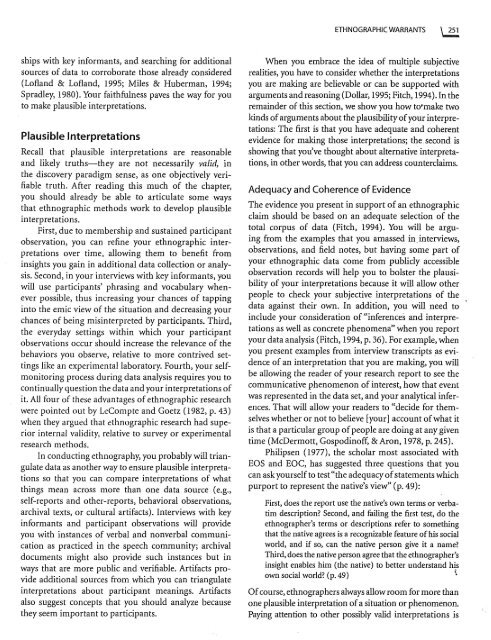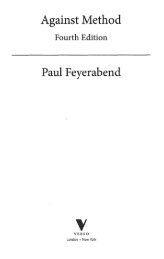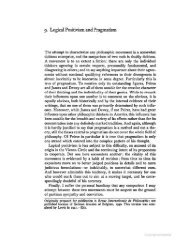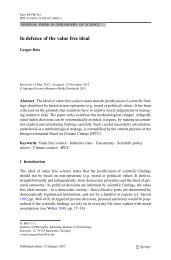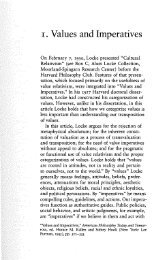Ethnographic Research - Matthew J. Brown
Ethnographic Research - Matthew J. Brown
Ethnographic Research - Matthew J. Brown
- No tags were found...
Create successful ePaper yourself
Turn your PDF publications into a flip-book with our unique Google optimized e-Paper software.
ETHNOGRAPHIC WARRANTS ~ships with key informants, and searching for additionalsources of data to corroborate those already considered(Lofland & Lofland, 1995; Miles & Huberman, 1994;Spradley, 1980). Your faithfulness paves the way for youto make plausible interpretations.Plausible InterpretationsRecall that plausible interpretations are reasonableand likely truths-they are not necessarily valid, inthe discovery paradigm sense, as one objectively verifiabletruth. After reading this much of the chapter,you should already be able to articulate some waysthat ethnographic methods work to develop plausibleinterpretations.First, due to membership and sustained participantobservation, you can refine your ethnographic interpretationsover time, allowing them to benefit frominsights you gain in additional data collection or analysis.Second, in your interviews with key informants, youwill use participants' phrasing and vocabulary wheneverpossible, thus increasing your chances of tappinginto the emic view of the situation and decreasing yourchances of being misinterpreted by participants. Third,the everyday settings within which your participantobservations occur should increase the relevance of thebehaviors you observe, relative to more contrived settingslike an experimental laboratory. Fourth, your selfmonitoringprocess during data analysis requires you tocontinually question the data and your interpretations ofit. All four of these advantages of ethnographic researchwere pointed out by LeCompte and Goetz (1982, p. 43)when they argued that ethnographic research had superiorinternal validity, relative to surveyor experimentalresearch methods.In conducting ethnography, you probably will triangulatedata as another way to ensure plausible interpretationsso that you can compare interpretations of whatthings mean across more than one data source (e.g.,self-reports and other-reports, behavioral observations,archival texts, or cultural artifacts). Interviews with keyinformants and participant observations will provideyou with instances of verbal and nonverbal communicationas practiced in the speech community; archivaldocuments might also provide such instances but inways that are more public and verifiable. Artifacts provideadditional sources from which you can triangulateinterpretations about participant meanings. Artifactsalso suggest concepts that you should analyze becausethey seem important to participants.When you embrace the idea of multiple subjectiverealities, you have to consider whether the interpretationsyou are making are believable or can be supported witharguments and reasoning (Dollar, 1995; Fitch, 1994). In theremainder of this section, we show you how to' make twokinds of arguments about the plausibility of your interpretations:The first is that you have adequate and coherentevidence for making those interpretations; the second isshowing that you've thought about alternative interpretations,in other words, that you can address counterclaims.Adequacy and Coherence of EvidenceThe evidence you present in support of an ethnographicclaim should be based on an adequate selection of thetotal corpus of data (Fitch, 1994). You will be arguingfrom the examples that you amassed in,interviews,observations, and field notes, but having some part ofyour ethnographic data come from publicly accessibleobservation records will help you to bolster the plausibilityof your interpretations because it will allow otherpeople to check your subjective interpretations of thedata against their own. In addition, you will need toinclude your consideration of "inferences and interpretationsas well as concrete phenomena" when you reportyour data analysis (Fitch, 1994, p. 36). For example, whenyou present examples from interview transcripts as evidenceof an interpretation that you are making, you willbe allowing the reader of your research report to see thecommunicative phenomenon of interest, how that eventwas represented in the data set, and your analytical inferences.That will allow your readers to "decide for themselveswhether or not to believe fyour 1 account of what itis that a particular group of people are doing at any giventime (McDermott, Gospodinoff, & Aron, 1978, p. 245).Philipsen (1977), the scholar most associated withEOS and EOC, has suggested three questions that youcan ask yourself to test "the adequacy of statements whichpurport to represent the native's view" (p. 49):First, does the report use the native's own terms or verbatimdescription? Second, and failing the first test, do theethnographer's terms or descriptions refer to somethingthat the native agrees is a recognizable feature of his socialworld, and if so, can the native person give it a name?Third, does the native person agree that the ethnographer'sinsight enables him (the native) to better understand hisown social world? (p. 49) \Of course, ethnographers always allow room for more thanone plausible interpretation of a situation or phenomenon.Paying attention to other possibly valid interpretations is


